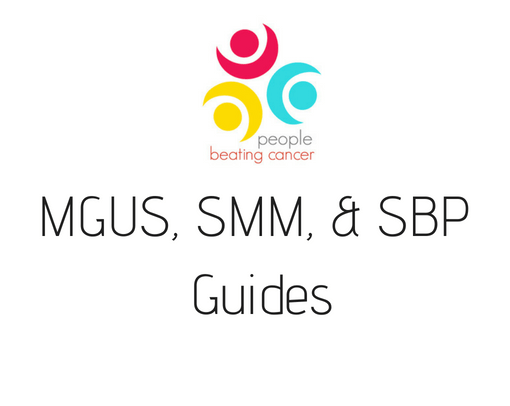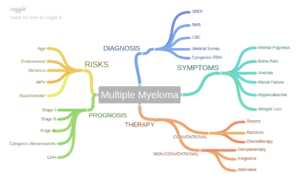
Diagnosed with SMM, SPB, or MGUS?
Learn how you can stall the development of full-blown Multiple Myeloma with evidence-based nutritional and supplementation therapies.
Click the orange button to the right to learn more.
- You are here:
- Home »
- Blog »
- Pre-Myeloma »
- Risk of MGUS in Relatives of MMers
Risk of MGUS in Relatives of MMers

“We and others have shown increased risk of monoclonal gammopathy of undetermined significance (MGUS) in first-degree relatives of patients with multiple myeloma (MM)…”
If you are a first-degree relative of a person who has an incurable blood cancer called multiple myeloma you will want to read this post. The study linked below identifies several issues that may involve your risk of MGUS, a form of pre-myeloma and therefore your risk of MM itself. Your three key take-away points are:
- Your risk of MM is about two and a half times that of the average person risk of MM-
- These risk of MM are in the single digits-
- You can reduce your risk of MM with evidence-based, non-toxic therapies.
I have lived with multiple myeloma since my diagnosis in early 1994. I have researched and studied both pre-myeloma as well as full blown multiple myeloma. While it is important to establish that the risk of MM is relatively small, whether you are an average person or a person with a first-degree relative of a person with MM, I must clearly state that you do not want to be diagnosed with MM. While there is a long and growing list of both conventional (FDA approved) and evidence-based non-conventional MM therapies, please understand that MM is an incurable blood cancer. You want to do everything possible to avoid a diagnosis of multiple myeloma.
click the image below to enlarge
 As you can see from the mind-map to the right, there are many risks that have been identified for MM. When I was first diagnosed with MM though I didn’t have a first-degree relative with MM, I did have several of the risks listed in the mind-map.
As you can see from the mind-map to the right, there are many risks that have been identified for MM. When I was first diagnosed with MM though I didn’t have a first-degree relative with MM, I did have several of the risks listed in the mind-map.
I firmly believe that people don’t take the steps necessary to lower their risk of cancer, any cancer, until they are diagnosed with cancer, any cancer. I say this because life keeps us all busy. Career, family, spouse- all keep us busy, all day, every day. In my case, I didn’t know my increased risks of MM. But even if I did, reducing my risks of MM would have been both easy and difficult.
By this I mean that nutrition, supplementation to reduce my risk of MM would have been easy to add to my day but other risks woud have been more difficult- I can’t change my genetic make-up nor could I change my job (working in a printing plant aka changing my environment).
If your parents, siblings, etc. are diagnosed with MM and you are reading this blog post, maybe, hopefully you will take the steps to lower your own risk of MM. Please watch the video below to learn about evidence-therapies that you can use to prevent the development of Multiple Myeloma:
Click here to get the FREE Pre-Myeloma Introduction Guide and follow along.
Click here to get the FREE Pre-Myeloma First Questions Guide.
Please watch the pre-myeloma video or webinar to learn about the pre-myeloma cancer coaching program. Let me know if you have any questions. Simply scroll down the page, post a question or comment and I will reply to you ASAP.
Thank you,
David Emerson
- MM Survivor
- Cancer Coach
- Director PeopleBeatingCancer
Recommended Reading:
Risk of MGUS in relatives of multiple myeloma cases by clinical and tumor characteristics.
“We and others have shown increased risk of monoclonal gammopathy of undetermined significance (MGUS) in first-degree relatives of patients with multiple myeloma (MM).
Whether familial risk of MGUS differs by the MM proband’s
- age at onset,
- tumor or clinical characteristics is unknown.
MM and smoldering MM (SMM) cases (N = 430) were recruited from the Mayo Clinic in Rochester, Minnesota between 2005-2015. First-degree relatives over age 40 provided serum samples for evaluation of MGUS (N = 1179). Age and sex specific rates of MGUS among first-degree relatives were compared to a population-based sample. Cytogenetic subtypes were classified by Fluorescence in situ hybridization.
MGUS was detected in 75 first-degree relatives for an age- and sex- adjusted prevalence of 5.8% (95% CI: 4.5-7.2). Prevalence of MGUS in first-degree relatives was 2.4 fold (95% CI: 1.9-2.9) greater than expected rates.
Familial risk did not differ by proband’s age at diagnosis, gender, isotype, IgH translocation, or trisomy. This study confirms first-degree relatives of MM cases have a significantly higher risk of MGUS compared to the general population, regardless of age, gender, or tumor characteristics. In selected situations, such as multiple affected first-degree relatives, screening of first-degree relatives of MM cases could be considered for follow-up and prevention strategies.”



